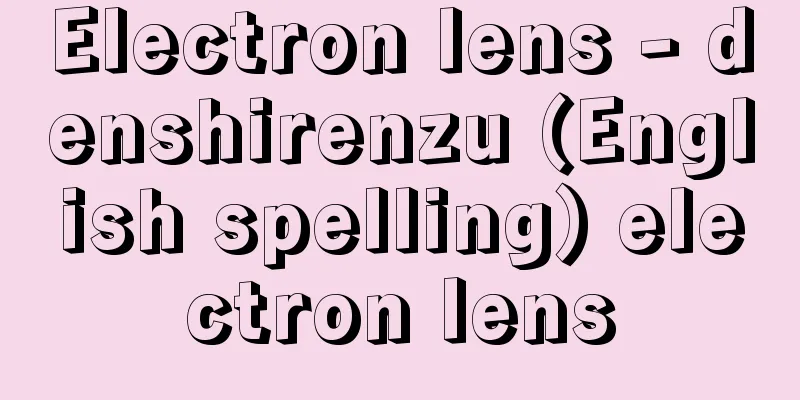Electron lens - denshirenzu (English spelling) electron lens

|
A device that works like an optical lens for electron beams. It has the function of focusing electron beams that come out in various directions from a single point back to a single point. Many of them are made of axially symmetric electromagnetic fields, and electrostatic lenses that use electric fields are used in cathode ray tubes, while magnetic lenses that use magnetic fields are used in electron microscopes. To understand the principle of operation of an electron lens, we must calculate the electron trajectory in an electromagnetic field, but below we will provide an intuitive explanation of an actual electron lens. shows an electrostatic lens used in cathode ray tubes, where electrons are accelerated and subjected to the lens action. Because the force acts perpendicular to the equipotential surface, the left half of the lens has a converging effect, while the right half has a diverging effect. However, in the right half, the electron beam speed is faster, so the diverging effect is smaller, and the lens as a whole becomes a convex lens. shows a magnetic lens used in electron microscopes, which differs from electrostatic lenses and optical lenses in that the electron speed does not change inside the lens. Because the force that an electron receives from a magnetic field is proportional to the vector product of the electron speed and the magnetic field, the incident electron begins to rotate around the optical axis due to the action of the radial component of the magnetic field. Once the electron starts to rotate, it then receives a force toward the center due to the action of the axial component of the magnetic field. This force becomes larger the further away from the axis it is, and acts as a convex lens. Even if the direction of the magnetic field is reversed, it does not become a concave lens, but remains a convex lens. This is because the magnetic field acts twice, resulting in a lens effect. The lens strength (the inverse of the focal length) is proportional to the square of the coil current, so the focal length can be changed continuously by changing the coil current. Electron lenses have the same types of aberrations (image blurring and distortion) as optical lenses, but magnetic lenses also have the additional problem of image rotation aberration. It has been theoretically proven that an axially symmetric electromagnetic field, such as the one given above, cannot be made into a concave lens, and for this reason it is impossible in electron optics to cancel out aberrations by using a combination of concave and convex lenses, as in optical lenses, to realize an optical system with low aberration. In fact, the resolution limit of an electron microscope is determined solely by the aberration of the objective lens. For this reason, the development of new electron lenses with low aberration continues, and a non-axially symmetric aberration correction lens reported in 1998 has attracted attention. [Akira Tonomura] [Reference item] |©Shogakukan "> Principle of electrostatic lens (Figure A) The electron beam that penetrates the object passes through the hole in the pole piece . Principle of magnetic lens (Figure B) Source: Shogakukan Encyclopedia Nipponica About Encyclopedia Nipponica Information | Legend |
|
電子線に対して光学レンズと同様の働きをする装置。一点からいろいろな方向に出た電子線をふたたび一点に集める機能を有する。軸対称電磁場からできているものが多く、電場を用いた静電レンズはブラウン管に、また磁場を使った磁界レンズは電子顕微鏡に利用されている。 電子レンズの動作原理を理解するには、電磁場中の電子軌道計算によらねばならないが、以下に実際の電子レンズについて直観的な説明を行う。はブラウン管に使われている静電レンズであるが、電子は加速されながらレンズ作用を受ける。力は等電位面に垂直な方向に働くため、レンズの左半分では収束作用になるが、右半分では発散作用になる。しかし、右半分の領域では電子線の速度が大きくなるために発散の効果は小さく、全体としてみると凸レンズになる。は電子顕微鏡で使われている磁界レンズだが、電子の速度はレンズの中で変化しないという点で、静電レンズや光学レンズとも異なっている。電子が磁場から受ける力は電子の速度と磁場のベクトル積に比例するため、入射電子は磁場の動径成分の作用によって、光軸を中心とする回転運動を始める。電子が回転し始めると、今度は磁場の軸方向成分の作用によって中心方向の力を受ける。この力は軸から離れるほど大きく、凸レンズの作用になる。磁場の方向を逆転しても凹レンズになるわけではなく、凸レンズのままである。これは磁場が二度働いた結果がレンズ作用になるためである。レンズの強さ(焦点距離の逆数)は、コイル電流の2乗に比例するので、コイル電流によって焦点距離を連続的に変えることができる。 電子レンズには、光学レンズと同種類の収差(像のぼけやひずみ)があるが、磁界レンズには、さらに像回転収差が付け加わる。例にあげたような軸対称電磁場は凹レンズにはなりえないことが理論的に証明されており、このため光学レンズのように凹凸の組合せレンズによって収差を打ち消し、収差の小さい光学系を実現することは電子光学系では不可能である。実際、電子顕微鏡の分解能限界は対物レンズの収差だけで決められている。このため、収差の小さな新しい電子レンズの開発が続けられ、1998年に報告された軸対称でない収差補正レンズに関心が集まっている。 [外村 彰] [参照項目] |©Shogakukan"> 静電レンズの原理〔図A〕 物体を透過した電子線はポールピースの穴を通る©Shogakukan"> 磁界レンズの原理〔図B〕 出典 小学館 日本大百科全書(ニッポニカ)日本大百科全書(ニッポニカ)について 情報 | 凡例 |
<<: Denshiwai Incident - Denshiwai Incident
>>: Microwave oven - denshirenji
Recommend
《Eisagoge》 - Eisagoge
…More than being an original thinker, he was the ...
Meles meles anakuma (English spelling) Meles melesanakuma
…[Hiroshi Aramata]. … *Some of the terminology ex...
International Economic Law
Law that regulates economic phenomena (internation...
Aega antillensis (English spelling)
…[Shigeo Gamou]. … *Some of the terminology that ...
Ubs-nuur (Lake)
An inland lake in the northwest of the Mongolian P...
Ooyae Kuchinashi - Ooyae Kuchinashi
→Gardenia Source: Shogakukan Encyclopedia Nipponi...
Society for Ethnomusicology
...Musicologists who were colleagues, assistants,...
Clerk - Tedai
〘noun〙① To act on someone's behalf. Also, that...
Goldammer, K.
... This kind of empirical and mystical philosoph...
Wallace, V.
… The tradition of church music is also long, and...
Estimated tax payment
Paying a portion of the income tax due before it i...
Kitagawa Utamaro
A late Edo period ukiyo-e artist. Kitagawa. Commo...
Rhys Davids, TW (English spelling) RhysDavidsTW
...In other areas such as philosophy and narrativ...
Polluter pays principle
…It is an acronym for the polluter pays principle...
《Shopiniana》(English spelling)Shopiniana
...A one-act ballet choreographed by Fokine to mu...









